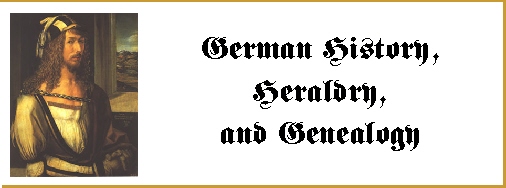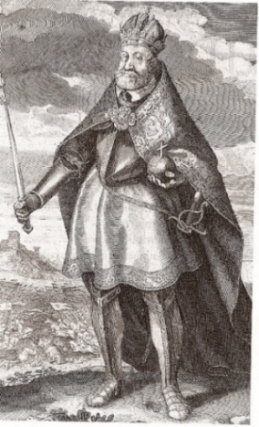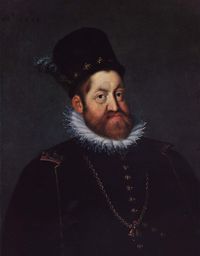

Rudolf II, Holy Roman Emperor
King of Hungary and Bohemia
Researched and compiled by Margaret Odrowaz-Sypniewska

In H.C. Erik Midelfort's book, Mad Princes of Renaissance Germany, Rudolf II (1552-1612) is listed as "mad." His "madness" comes from Ferdinand of Aragon and Isabella of Castile's daughter, Juana (1479-1555) "La Loca" of Castile, Spain.
His family tree:
Rudolf's other great-grandparents were Manuel I of Portugal, and Maria of Aragon, parents of Isabella of Portugal.
WHY RUDOLF II WAS CONSIDERED "MAD":

RUDOLF'S PROBLEMS AS KING AND HOLY ROMAN EMPEROR:
Rudolf's family gave him absolutely no support. In 1598, he mourned the death of his Uncle Philip II of Spain. He had fond memories of his early life in his uncle's court. His cousin Philip III was only interested in bullfights.
Rudolf's family was always trying to get him to marry so he could have legitimate heirs. He had a falling out with his brothers Albrecht and Maximilian since they ended up marrying his chosen "future wives." Apparently Rudolf saw this as a break of trust. Even though he had no intention of marrying them himself. Rudolf was more interested in art and science than conjugal love and warmth. His mistress, Katharina stayed in Rudolf's castle for seventeen years, but he rarely saw her or their children.
THEIR CHILDREN WERE:
1. Catharine his eldest daughter bore by Katharina married.
In 1558, there was a solar eclipse, two lunar eclipses, and the passage of a comet; AND the conjunction of Jupiter and Mars. These unusual planetary events made him extremely superstitious, thus his court of astronomers, astrologists, and those with occult tendencies.
Rudolf tried to have his brother Maximilian in Poland since 1587 released. Maximilian tried to invade Poland and crown himself king. Sigmund Batory was the King of Poland and he wanted Jiri Popel of Lobkovic as King of Bohemia, rather than Rudolf. Rudolf was furious! As Holy Roman Emperor Rudolf was to defend Catholicism, but he disliked the idea of the Vatican interferring in his personal and imperial affairs. Rudolf refused to support the Catholics or the Protestants.
WHY RUDOLF'S ELDEST SON WAS CONSIDERED MAD:
Don Julius Caesar died in June 25, 1609, three years before his father, in 1612. Don Julius was his father's favorite son, but before his death, he was a great source of anguish and embarrassment to his father. Many think that Don Julius' son added to his father's melancolia later in life. All of his adult life the Don was considered a lecherous tyrant. A few years before his death, he made more brutal advances towards the maidens of the town around December 1606.
Then by 1607 he took the daughter of a local barber-surgeon and bath-house operator, named Maruska, as his concubine. We are not certain if Maruska agreed to this arrangement. All we do know is that she must not pleased have him, or went along with his proverted sexual acts.
By 1608, Don Julius' violence was totally out of control. He attacked his unlucky concubine, Maruska, with a knife or a sword and threw her blood-drenched body from his window. The fall did not result in her death, since she landed in the castle pond. She quickly ran to seek solace with her father. Maruska was nursed back to health in her parent's loving care. As soon as Don Julius heard that she was still alive he wanted Maruska back. Her family refused.
Don Julius had Maruska's father arrested and then tortured him in prison for five weeks, hoping that he would change his mind. Then her father was scheduled to be killed unless Maruska returned to his bed. The poor girl was tortured both physically and mentally, and her mother made Julius swear that he would not harm her in any way. Their mistake was that they believed he had reformed. Maruska's father was released, and Maruska return to Don Julius's bed chamber, to save her father from certain death. Of course, Don Julius was so insane that he returned to violent acts toward Maruska immediately.
That very night Maruska's screams of terror were heard. The poor girl was stabbed twice in the hand, and once in the chest. Then Don Julius ordered her to put on a fur-lined nightgown, he bought for her, and ordered her to go to his bed. Julius joined her and when she turned away from him in disgust (as one can only imagine). All this happened behind a locked door and only his shouting revealed his actions. He went berserk!!! He stabbed Maruska again and again. He cut off both her ears, knived her in the eye, and smashed out her teeth. If that was not bad enough, Julius split her skull until all her brain matter spilled out. By this time, we can assume that the poor girl was dead and could not feel any pain?
When the servants notified the higher officials they broke into the chamber and found Don Julius naked and covered in feces, blood, and carnage. As they looked around the room, they saw pieces of Maruska's body
everywhere. By now Don Julius was weeping and asked
them to wrap the body in linen and remove it from his chambers. He came to see the result of his insanity the next day and put her into a coffin and nailed it shut. Maruska was given an elaborate funeral and buried in the local cloister. She died on February 16, 1608.
Don Julius never cleaned hmself so he walked around covered in her gore and his own excretement. A few days later, he was imprisoned for the rest of his life. In March 1608, he was found naked in his cell. Priests came to get him to confess his sins. He died on June 25, 1609.
He was suicidal for much of his life, and liked many different types of sexual excesses. His cousin, Don Carlos, son of Philip, was epileptic, lame, and hunchbacked. His birth defeats were caused by the marrying of cousins which happened too often in the Habsburg family. This is also why scientists think Don Julius Caesar was "mad." It was bad genes.
WHY RUDOLF'S MOTHER WAS MAD:
Rudolf was coronated in the Cathedral of St. Vitus, in Prague Castle, on September 22, 1575. His crown was constructed in 1602 by goldsmith Hans Vermeyen. Rudolf was a discerning art patron.
To Rudolf II's credit, he was a scholar. His castle was in Prague. It was named Hradschin Castle. Rudolf is best known for his scientific studies into alchemy, astronomy, and the occult. Natural magic, in the Middle Ages and during the Renaissance was science.
RUDOLF'S SCIENTIFIC HEROES AND COURTIER'S WERE:
In his calm state, Rudolf was described as "measured and reasonable." He was well-informed and curious. He spoke German, Spanish, Italian, Latin, and French. He understood Czech. He was enigmatic and could be generous and humane. However, he was rather disappointed with the world in general, and Rudolf insisted on complete obedience in regards to his ministers.
Rudolf collected clocks, and had a passion for plants and animals. He loved his lion, which was a gift from the Sultan of Turkey. The lion was an ancient symbol of rank and power. The lion was one of the oldest symbols of the Bohemian Kings, as Holy Roman Emperors. As part of his love for plants, he developed Stromovska, one of Prague's oldest and largest parks. He was involved in the Noble Order of the Golden Fleece established in January 1430 at the wedding of Duke Philip and Isabella of Portugal. Rudolf ran his own stud farm at Kladrubylt. Most nobles liked his scholarship, even though they themselves were often illiterate. Those who were prominent in Rudolf's court were the Rozmberks, Vilems, and Peter Vok. None of these lines continued, since none of them produced heirs.
Rudolf had a very well-stocked library, which was touted as one of the best in Europe. Nostradamus cast Rudolf's birth chart, as did Dee and others. He always wanted to know his fate and was always thinking his death would come in a rare fashion.
Rudolf was to marry Isabella (d. 1633), daughter of Philip II (1527-1598). Isabella was his Spanish cousin. However, after he repeatedly refused to marry again and again, she was married to his brother Albrecht of Austria.
Marie de Medici was another candidate, as wife for Rudolf. She, like Isabella, was married to another. Maria married Henry IV of France. The last "future wives" were Margaret of Savoy, daughter of Charles Emmanuel of Savoy and his cousin, Anne of Tyrol.
Rudolf II had a passion for the works of Albrecht Durer, and he collected his paintings and woodcuts.
One of Rudolf II's enemies was Sigismond Bathory. He never trusted him and his suspicions were justified. George (Popel) Lobkovic was the High Steward of Bohemia and a supporter of the Catholic Church. George was a friend of Bathory. One must be made aware that Rudolph's father was Lutheran and his mother was a rigid Catholic. Rudolf favored his father's religion, which made him an enemy of the Catholics. His two detractors were Bathory and Lobkovic. They often "informed" the Catholic Church of his supposed anti-Catholic activities. When Rudolf found out that Lubkovic was the main perpetrator of these rumors, he sent Lobkovic to the dungeons for his own self promotions. George Lobkovic remained in jail without pardon for fourteen years. His pardon came only with his own death.
RUDOLF'S DEATH:
Rudolp was always fearful of getting the plague, but that was not what killed him. Rudolf caught bronchitus and his leg began to swell. He wore his shoes, in spite of the advise of his doctors, and after two days gangrene set in. His lungs were damaged and his liver inflamed. Rudolf refused drugs and would not allow doctors to wash his wounds. Instead he tried a potion from a Scottish alchemist named Seton, which contained amber and finely ground gallstones. Seton's formula, as might be expected, did not help his condition. Rudolf died three days after the death of his favorite lion, on January 20, 1612. In his final hours of life, he rejected the sacraments like his father, Maximilian II.
After his brother's death, Matthias sent Rudolf's artists, alchemists, and astrologers from court, and they hired on with other rulers. Rudolf II would not have approved of this act. An era ended.
SOURCES:
Evans, R. J. W. Rudolf II and His World. Oxford: Thames and Hudson, 1997.
Heer, Friedrich. The Holy Roman Empire. London: Phoenix, 2002.
Kitchen, Martin. Cambridge Illustrated History of Germany. Cambridge: Cambridge University Press, 2000.
Marshall, Peter> The Magic Circle of Rudolf II: Alchemy and Astrology in Renaissance Prague. New York: Walker & Company, 2006.
Midelfort, H.C. Erik. Mad Princes of Renaissance Germany. Charlottesville: University of Virginia Press, 1996.
2. Daughter was a nun in Vienna.
3. Daughter was a nun in Madrid.
4. One son was killed by a friend, in an alley in Vienna, after a dispute over a prostitute.
5. Another son died in the Thirty Years war.
6. Don Julius (see below)
